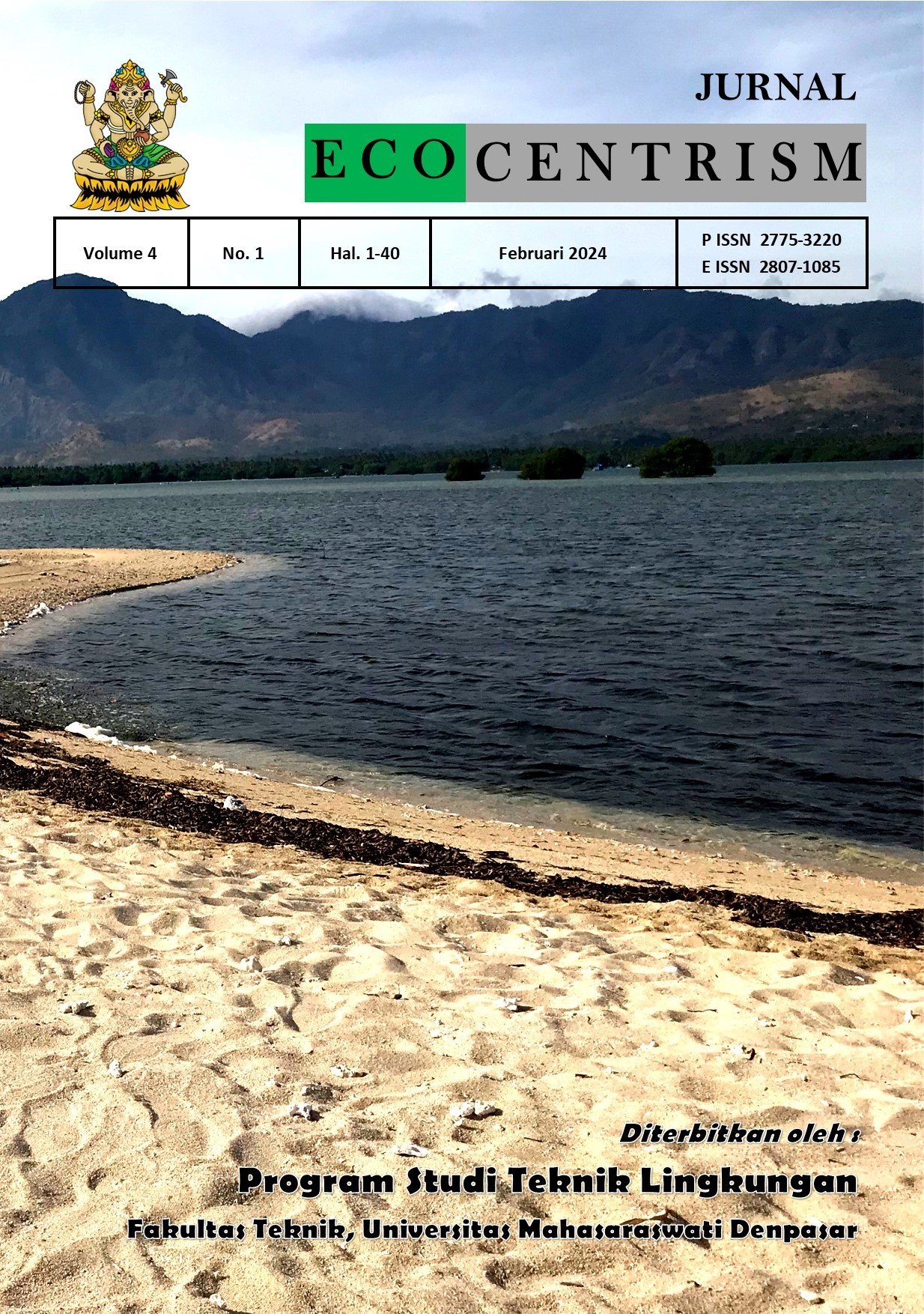ANALISIS KARAKTERISTIK SAMPAH DALAM MENENTUKAN OPTIMALISASI KINERJA PENCACAHAN DI TPS 3R KESIMAN KERTALANGU
Keywords:
water content of waste, wash out, maximum sorting, shredding speed, carry over effectAbstract
The increasing population causes an increase in the amount, variety and characteristics of waste. Good waste processing and management is needed to deal with waste problems. TPS 3R Kesiman Kertalangu is an independent waste processing site in Kesiman Kertalangu Village. There is mixed and residual waste entering TPS 3R Kesiman Kertalangu. In processing the waste into compost, the waste is first sorted and shredded. In this research, several experiments were carried out to determine the maximum sorting and shredding speed. The water content of the waste studied included: 25%, 50%, 75%. The research method used is the experimental method. Determining the water content of waste is done first by observing the daily weather to obtain the desired water content. Apart from that, there is a wash out of sorting personnel in sorting waste to get accurate data, so that there is no carry over effect. Measuring shredding speed uses the SNI 7580:2010 approach as a reference that is close to the basis of research. Based on research results, waste water content of 25% is the maximum waste for sorting. Apart from that, waste with a water content of 25% is also the waste that is shredded the fastest.
References
Alwi, I. 2020. Kriteria Empirik Dalam Menentukan Ukuran Sampel Pada Pengujian Hipotesis Statistika Dan Analisis Butir. Jurnal Formatif, 2(2), 140-148.
Badan Standar Nasional. (2010). SNI 7580:2010 Mesin pencacah (chopper) bahan pupuk organik - Syarat mutu dan metode uji.
Badan Standarisasi Nasional. (2002). SNI 19-2454-2002 Tata Cara Teknik Operasional Pengelolaan Sampah Perkotaan.
Bhiungade, V. dkk. (2023). ‘Solid Waste Management Using Shredding And Segregation Machine’, www.irjmets.com @International Research Journal of Modernization in Engineering, 3340. Dapat diakses pada: www.irjmets.com.
Budiman dan Suyono (2010). Ilmu kesehatan masyarakat dalam konteks kesehatan lingkungan. Jakarta: EGC
Chusnul, C. (2020). Pengelolaan Sampah Dan Pengembangan Ekonomi Kreatif Di Kawasan Destinasi Wisata Pesisir Pantai Selatan Tulungagung.Pdf. Tulungagung: Akademi Pustaka, pp. 1–69. Dapat diakses pada: http://repo.iaintulungagung.ac.id/15001/1/Buku Pengelolaan Sampah.pdf. Diakses Tanggal 22 Agustus 2023
Damanhuri, E dan Padmi, T. (2004). Diktat Kuliah Pengelolaan Sampah. ITB: Bandung. Diakses tanggal 28 Agustus 2023
EPA (Environmental Protection Agency). (1975). Solid Waste Shredding and Shredder Selection.
Hajar, I. (1996). Dasar-Dasar Metodologi Penelitian Kwantitatif Dalam Pendidikan. Jakarta: Raja Grafindo Persada.
Harlyan, L.I. (2013). Ukuran Pemusatan. Dapat diakses pada: http://ledhyane.lecture.ub.ac.id/files/2013/07/ukuran-pemusatan.pdf.
Kannan, B. (2013). Lesson-26 Characteristics of solid waste, Course Content.
McDougall F, White P, Franke M and Hindle P. (2001). Integrated Solid wase Management: Life Cycle Inventory Second Edition. Blackwell Publishing Company. Malden USA
Nabegu, A. B. (2010). An Analysis of Municipal Solid Waste in Kano Metropolis, Nigeria. Journal Hum Ecol, 31(2), 111- 119.
Nugroho, P. (2013). Panduan Membuat Kompos Cair. Jakarta: Pustaka baru Press.
Ojolo, S. J., Orisaleye, J. I., Adelaja, A. O., & Kilanko, O. (2011). Design and Development of Waste Sorting Machine. Journal of Emerging Trends in Engineering and Applied Sciences (JETEAS), 2 (4), 576-580.
Pokja PPAS. (2013). Peraturan Menteri Pekerjaan Umum Nomor 3 Tahun 2013 Tentang Penyelenggaraan Prasarana dan Sarana Persampahan Dalam Penanganan Sampah Rumah Tangga dan Sampah Sejenis Sampah Rumah Tangga.
Pramono, C dan Mawarsih, E. (2015). Kapasitas Mesin Pencacah Sampah Skala Rumah Tangga Menggunakan Motor Penggerak 0,25 Hp. Inovasi. Vol 42 (1)
Rajput, R., Prasad, G., & Chopra, A. K. (2009). Scenario of Solid Waste Management in Present Indian Context. Caspian Journal of Environmental Science, 7 (1), 45-53.
Rizal, M. (2011). Analisis Pengelolaan Persampahan Perkotaan (Studi Kasus pada Kelurahan Boya, Kecamatan Banawa, Kabupaten Donggala. Jurnal SMARTek, 9 (2), 155-172.
Sahil J, dkk. (2016). Sistem Pengelolaan dan Upaya Penanggulangan Sampah di Kelurahan DufaDufa Kota Ternate. Jurnal Bioedukasi volume 4 nomor 2. ISSN: 2301-4678/ media.neliti.com
Sanjaya dan Wina. (2013). Strategi Pembelajaran Berorientasi Standar Proses Pendidikan. Jakarta: Kencana.
Shinta, E.M dan Mahendra, N.L.P (2022). Implementasi Pengomposan Dan Eco Enzymedalam Pengolahan Sampah Rumah Tangga Di Kelurahan Abianbase. Jurnal Ecocentrism, Vol. 2 (2), 30-42.
Sudrajat. (2006). Mengelola Sampah Kota, Jakarta: Penabar Suwadaya.
Tchobanoglous, G., Theisen, H., & Vigil, S. A. (1993). Integrated Solid Waste Management. New York: Mc Graw-Hill International Edition.
Undang-undang No. 18 Tahun 2008 tentang Pengelolaan Sampah
Upadhyay, V., S, J. A., & P, P. M. (2012). Solid Waste Collection and Segregation: A Case Study of MNIT Campus, Jaipur. International Journal of Engineering and Innovative Technology (IJEIT), 1(3), 144-149.
Wahyu Wijaya, I.M dan Ardi Putra, I.K. (2021). Potensi Daur Ulang Sampah Upacara Adat Di Pulau Bali. Jurnal Ecocentrism Vol. 1 (1).


